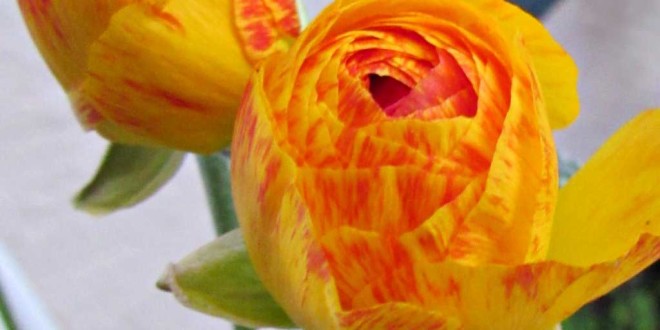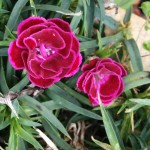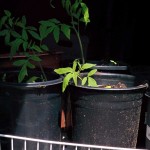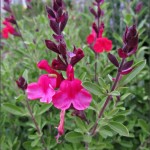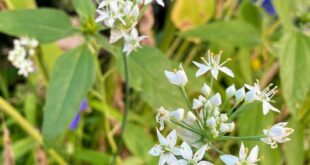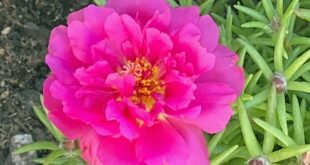March came in like a wet lion and went out as a warm and dry lamb.
Spring Flowers - Ranunculus
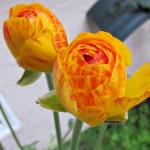 We have had a good bloom from the Ranunculus that we planted in November. Ranunculus come in multiple layers of delicate, crepe paper–thin petals, looking like an origami masterwork. Each yellow petal is tinged with a darker red. Ranunculus (R. asiaticus) excel in southern and western gardens, and make terrific container plants everywhere. They also make long-lasting cut flowers. Bulbs are widely available in Fall at retail nurseries in mild-winter climates. Ranunculus naturalize so you can enjoy year after year with little effort.
We have had a good bloom from the Ranunculus that we planted in November. Ranunculus come in multiple layers of delicate, crepe paper–thin petals, looking like an origami masterwork. Each yellow petal is tinged with a darker red. Ranunculus (R. asiaticus) excel in southern and western gardens, and make terrific container plants everywhere. They also make long-lasting cut flowers. Bulbs are widely available in Fall at retail nurseries in mild-winter climates. Ranunculus naturalize so you can enjoy year after year with little effort.Spring Flowers - Anemone
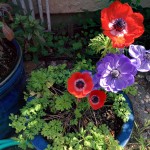 Our Anemone plants continue to have a lot of colorful spring blossoms of red and purple. Anemones are also a member of the Ranunculus family. They easily grow in shallow containers and also naturalize. Anemone means “daughter of the wind”, from ánemos the wind god “wind” + feminine Patronymic suffix -ōnē. The plant was created by the goddess Venus when she sprinkled nectar on the blood of her dead lover Adonis.
Our Anemone plants continue to have a lot of colorful spring blossoms of red and purple. Anemones are also a member of the Ranunculus family. They easily grow in shallow containers and also naturalize. Anemone means “daughter of the wind”, from ánemos the wind god “wind” + feminine Patronymic suffix -ōnē. The plant was created by the goddess Venus when she sprinkled nectar on the blood of her dead lover Adonis.Blue-eyed grass
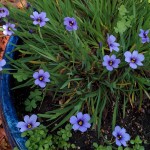 2016 is the second year for our Narrow-leaf Blue-eyed grass. Sisyrinchium angustifolium is noted for its violet-blue flowers and branched flowering stems. Though their foliage is grass-like, the blue-eyed grasses belong to the iris family not the grass family. It is native to southeast USA where it occurs in damp open woods, slopes and along stream banks.
2016 is the second year for our Narrow-leaf Blue-eyed grass. Sisyrinchium angustifolium is noted for its violet-blue flowers and branched flowering stems. Though their foliage is grass-like, the blue-eyed grasses belong to the iris family not the grass family. It is native to southeast USA where it occurs in damp open woods, slopes and along stream banks.
Spring flowers - Sparaxis
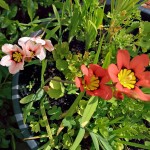 For 2016, we planted Sparaxis. These South African bulbs need just two inches of soil over them and can often be planted by just poking them in with your finger. In a few minutes, you’re done! And a colorful spring bloom awaits you. The colorful flower heads with petals of cream and red around a yellow center ringed with black bob in the wind on their thin stalks.
For 2016, we planted Sparaxis. These South African bulbs need just two inches of soil over them and can often be planted by just poking them in with your finger. In a few minutes, you’re done! And a colorful spring bloom awaits you. The colorful flower heads with petals of cream and red around a yellow center ringed with black bob in the wind on their thin stalks.
Carnations
Sweet Kate
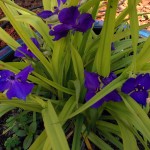 Brilliant gold leaves highlight the deep blue/purple flowers of ‘Sweet Kate‘ (Tradescantia). The plant forms dense spreading clumps of erect narrow strap-like leaves. Three petaled flowers form from late spring into fall. The stamen stems are the same pleasing lavender blue and have an enchanting bright yellow dot of pollen on each that appears to magically float above the flower. Excellent for providing some color in difficult locations, or in naturalized plantings. Stunning when paired with daylilies. It’s a perennial and can thrive in a wide shallow pot. I have minde under the cherry tree
Brilliant gold leaves highlight the deep blue/purple flowers of ‘Sweet Kate‘ (Tradescantia). The plant forms dense spreading clumps of erect narrow strap-like leaves. Three petaled flowers form from late spring into fall. The stamen stems are the same pleasing lavender blue and have an enchanting bright yellow dot of pollen on each that appears to magically float above the flower. Excellent for providing some color in difficult locations, or in naturalized plantings. Stunning when paired with daylilies. It’s a perennial and can thrive in a wide shallow pot. I have minde under the cherry treeCherries
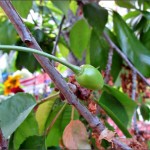 We have a 15-year old mature Lapins cherry tree planted in our former swimming pool. The Lapin is advertised as self-fertile and has lots of flowers but has produced few fruit. The ground has 1 foot of soil covering 8 feet of coarse sand. The tree is 15 feet tall with a twelve foot diameter drip line. Once a year, I place the recommended number of fruit-tree fertilizer stakes around the drip-line.
We have a 15-year old mature Lapins cherry tree planted in our former swimming pool. The Lapin is advertised as self-fertile and has lots of flowers but has produced few fruit. The ground has 1 foot of soil covering 8 feet of coarse sand. The tree is 15 feet tall with a twelve foot diameter drip line. Once a year, I place the recommended number of fruit-tree fertilizer stakes around the drip-line.
The tree has a lot of flowers but few fruit. I thought the tree might not be self-fertile so I planted a Bing cherry tree next to it, hoping for cross-pollination. The Bing tree started flowering two weeks after the Lapins tree flowered. The amount of cherries from either tree wasn’t great. So I could not confirm that cross-pollination was occurring.
The next step was to try grafts. In Spring 2015, I returned from the Santa Clara Valley Fruit Growers Exchange with six scion branches that I grafted onto my mature Lapins cherry tree. Three of the six grafts took. This year, all three grafts have produced fruit.
My next theory is that the developing fruit are dropping due to drought stress. The tree is in the remains of a swimming pool so its only moisture comes from rain or lawn sprinkers. In 2015, I removed the lawn. So in 2016, I have decided to water the trees more heavily. During the fruiting season (late spring and into summer), a mature cherry tree can use 37 gallons per day through evapotranspiration (according to a UC document). Every 3 days I run the hose at full volume (10 gallons per minute) for 10 minutes.
Apricots
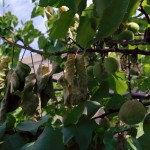 The decision to not spray fungicide in January was a mistake: both Blenheim apricot trees and both nectarine trees are suffering from fungus problems. Lots of small branches (and a few larger ones) wither and die. I am removing fuzzy mummy fruits when they appear. I am going to remove one of the nectarines and replace it with the Panache Fig
The decision to not spray fungicide in January was a mistake: both Blenheim apricot trees and both nectarine trees are suffering from fungus problems. Lots of small branches (and a few larger ones) wither and die. I am removing fuzzy mummy fruits when they appear. I am going to remove one of the nectarines and replace it with the Panache Fig
Figs
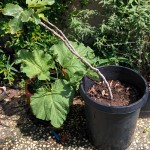 My brother Adam came up from southern California with a Panache Fig tree in a 10-gallon pot. The Panache Fig (aka Tiger Fig) has a yellow and green-striped skin with a strawberry-colored flesh. Unlike our Black Mission Fig, the Panache Fig does not have a spring crop. It is supposed to have a larger fall crop. Because it loves the heat, I will pot it next to our south facing wall. Note: the 3 giant leaves near the ground are from our second-year Rhubarb.
My brother Adam came up from southern California with a Panache Fig tree in a 10-gallon pot. The Panache Fig (aka Tiger Fig) has a yellow and green-striped skin with a strawberry-colored flesh. Unlike our Black Mission Fig, the Panache Fig does not have a spring crop. It is supposed to have a larger fall crop. Because it loves the heat, I will pot it next to our south facing wall. Note: the 3 giant leaves near the ground are from our second-year Rhubarb.
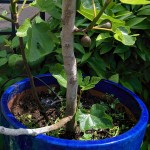 In 2015 I tried several trunk grafts of fig scions on our Black Mission Fig tree to increase yield. None of them took. However it seems to have scared the fig tree into producing a sucker trunk that has produced several fall fruits and has fruit this spring. While the literature suggests removing it, as long as the fruit are tasty and the yield is up, I will live the second trunk.
In 2015 I tried several trunk grafts of fig scions on our Black Mission Fig tree to increase yield. None of them took. However it seems to have scared the fig tree into producing a sucker trunk that has produced several fall fruits and has fruit this spring. While the literature suggests removing it, as long as the fruit are tasty and the yield is up, I will live the second trunk.
Mulberry
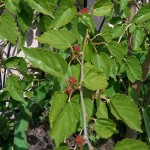 We have a dwarf Black Mulberry tree growing in a large container. At this age the tree is shrub-like with several trunks about 6 feet tall from soil-height. During a wind storm, the trunks were really moving but they survived. This is the first year it is flowering and has set fruit. The flowers are tiny (a fraction of an inch) and unimpressive. The fruit when small are reddish. The mature fruit will turn black and resemble a blackberry. It is said they make good preserved jams and jellies.
We have a dwarf Black Mulberry tree growing in a large container. At this age the tree is shrub-like with several trunks about 6 feet tall from soil-height. During a wind storm, the trunks were really moving but they survived. This is the first year it is flowering and has set fruit. The flowers are tiny (a fraction of an inch) and unimpressive. The fruit when small are reddish. The mature fruit will turn black and resemble a blackberry. It is said they make good preserved jams and jellies.
Citrus
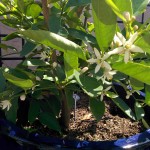 Our 4-year-old Bearss Lime tree is blossoming! Our only citrus tree grown in a container (a large 24-inch wide ceramic pot). Last year it had citrus leaf curl and produced no fruit. During the fall, I remove all the diseased leaves. This spring the tree has many blossoms and fruits including the branches that were almost stripped.
Our 4-year-old Bearss Lime tree is blossoming! Our only citrus tree grown in a container (a large 24-inch wide ceramic pot). Last year it had citrus leaf curl and produced no fruit. During the fall, I remove all the diseased leaves. This spring the tree has many blossoms and fruits including the branches that were almost stripped.
During March, I heavily pruned (30% cut back) our 40-year-old Tangerine tree. That tree is in a 24-inch wide side trench.
Our 40-year-old Oro Blanco Grapefruit tree continues to produce lots of fruit. I topped it to the 9-foot height of our neighbor’s garage.
Our 15-year-old Washington Naval Orange tree finished its fruits and is blossoming. The orange tree is growing in the same 24-inch wide trench that runs the length of the side of the yard for 100 feet.
Our 15-year-old Improved Meyers Lemon continues to produce all the lemons we need.
Tomatoes
Summer flowers
Due to the wet El Nino winter, the Amaryllis belladona bulbs (commonly known as pink ladies or naked ladies), are having a bumper growth this year. The bulbs produce fleshy leaves from January through April; then the leaves die off; and finally in August the flower stalks/scapes emerge with their gorgeous pink flower heads.
The dahlias have broken the ground surface.
Berries
During the last few days of March, our blackberry bushes are flowering. This is two weeks earlier than 15 years ago.
The hanging baskets are doing well with their purple and pink Pericallis, multi-colored Primrose, and purple Lantana, surrounded by shorter plants like Bacopa, Lithodora, Pansies and Violas. I have drip-irrigation running to the hanger poles but the plants still require more shade in the afternoon because of the solar heat reflected off of 9 foot tall stucco walls.
The winter vegetables I planted in November (cabbage, kale, carrots and beets) continue to grow but the obstacles to a bountiful harvest are huge. The winter is neither cold or long enough and these crops do better in the ground rather than in containers.
In our courtyard, I have had to open the umbrella to provide more shade. The Hisbiscus was suffering from reflected heat. The pink knotweed groundcover is booming.
